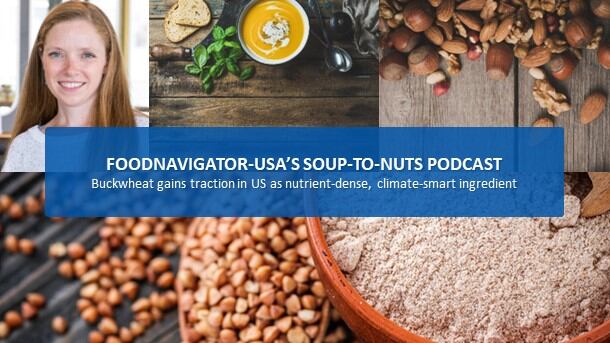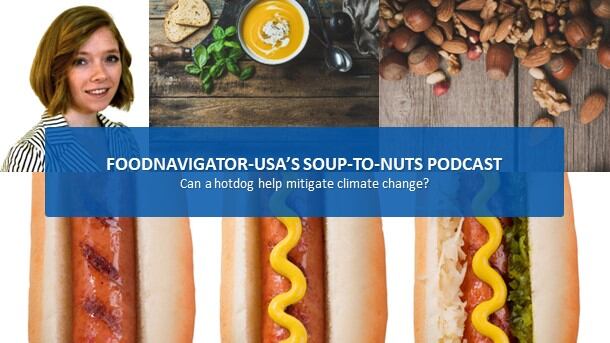A handful of innovative entrepreneurs using buckwheat in a wide range of products from plant-based milk and granola to bread, crackers and crisps are banding together to drive US consumer awareness and demand for the seed, which despite its name is not a type of wheat or even a grain. Rather, as a seed it is naturally gluten-free – and, according to several startups using it, is more nutritious than many of the gluten-free flours currently used.
The group also is working closely with farmers to scale supply of the crop, which offers many environmental benefits, including as a cover crop that hosts nitrogen-fixing bacteria, has abundant, fine roots that can loosen topsoil and which thrives in poor soil.
With so much going for buckwheat, the seed earned a coveted spot on Whole Foods Market’s list of Top 10 Food Trends for 2024 as well as on trendspotting lists published earlier this year by TODAY and The New York Times.
In this episode of FoodNavigator-USA’s Soup-To-Nuts podcast, buckwheat champions BAM, For Good Granola and Better with Buckwheat share what they love about the seed and how they are using it to win over American consumers, retailers and farmers. The also discuss how the seed can improve the health of people and the planet. The tightknit group of entrepreneurs, which spoke with FoodNavigator-USA at Natural Products Expo West, also outlines how they are working together to address several challenges that threaten to hold buckwheat back and where they see untapped potential.
[Editor’s Note: Never miss an episode of FoodNavigator-USA’s Soup-To-Nuts podcast – subscribe today.]
Introducing buckwheat to mainstream America
As one of the world’s first domesticated crops, buckwheat has a rich history in diets around the world, but according to Better With Buckwheat CEO Lewis Goldstein it has yet to break into mainstream US culture in part because until recently it was not easily available in convenient, nutritious products that also taste good.
“People are aware of buckwheat…. In the United States, it has the second highest awareness behind quinoa. So, they are aware of it, but they do not know a lot about it,” beyond their grandmother making pancakes with it, Goldstein said.
“It is our job to educate,” he added, noting buckwheat has been around for thousands of years and Russians consume 34 pounds per capita, while Ukrainians consume 22 pounds per capita.
Despite buckwheat’s popularity in Japan, Italy, France and Spain, it has not gained much traction in the US because there are not many “really delicious products that someone can buy off the shelf and feed their family and feel good about,” Goldstein said.
Goldstein added that Better With Buckwheat is trying to fill the void with a range of craveable crackers and crisps that are sweet and savory and which appeal not only to gluten-free dieters, who may have limited choices, but all consumers – including picky children and sophisticated adult foodies.
He explained that Better With Buckwheat began as Maine Crisp, which was the brainchild of a founder who was an award-winning cheesemaker and who could not find a gluten free cracker that she thought was good enough for her cheese.
When she discovered buckwheat, she created a line of crisps that recently grew with the addition of crackers under the Better With Buckwheat umbrella. The crisps and crackers pair buckwheat with fruits, nuts and spices to create a well-rounded taste experience.
Buckwheat’s complex taste profile is the canvas for For Good Granola
The complex taste profile of buckwheat, along with its ability to play well with a wide range of flavors was what attracted Chief and Founder of For Good Granola, Kiley Fields, to use the seed as the star ingredient in her new line of granolas. A chef by trade, Fields also notes the texture of buckwheat helps set it apart from other more traditional ingredients, like oats, and other seeds, like chia.
“Buckwheat makes for a flavor profile that is just crazy different,” with a complexity that brings out nutty notes when roasted and a substantial texture that holds up well to moisture and which does not have a residual aftertaste like some other common ingredients in granola, she said.
With buckwheat as her canvas, Fields is pushing the envelope for what granola can be and how it is consumed. She offers a range of flavors that are sweet and lean towards more traditional breakfast, including a Cranberry Spice, but also options that can serve as bar snacks, such as her Smokey Pineapple granola, or as a topping on soup and roasted vegetables, such as her Sweet Curry option.
To help consumers understand the range of uses beyond yogurt parfaits or as overnight groats, Fields recently launched a pairing guide that shares how to use the granolas across different dayparts and uses.
Buckwheat is a sustainable crop that addresses emerging climate concerns
As important as taste and convenience are in creating successful CPGs, buckwheat can also help brands tap into emerging trends and consumer priorities – including a rising demand for climate-friendly foods, according to the CEO and Founder of plant-based milk brand BAM, Paige Hansen.
“BAM is the first plant-based milk made from buckwheat available in the US, and BAM stands for Because Agriculture Matters. Really, my intention is to have a subtle, friendly reminder that nearly everything … we eat and drink comes from the soil,” and soil health is deeply connected to personal health and environmental health, Hansen said.
“The essence of my mission, plainly stated, is to get more climate smart crops into your favorite food and beverage products,” she added.
Buckwheat checks this box in part because it is a phosphorus scavenger, is pollinator friendly and offers other benefits to the soil, she said.
Educating consumers about buckwheat with bite-size messages
Explaining “climate smart crops” or “regenerative agriculture” to consumers is a heavy lift but important task for CPG brands, and Hansen does it with illustrations and simple call-outs on the packaging of her plant-based milk.
She explains that her label features a line drawing of buckwheat’s roots and flowers so that consumers can see the connection between the soil and what they are eating. She also is in the process of certifying her milk as regenerative.
The brand communicates its human health benefits with easy-to-understand claims, including as a complete source of plant-based protein.
Hansen notes that buckwheat is also “nutrient dense.”
According to Harvard Medical School, which featured buckwheat as its “grain of the month” last April, the seed is high in fiber, which could help lower cholesterol levels and manage blood glucose. It also has several minerals and rutin, which is a compound that may make blood vessels stronger and more flexible.
Hansen adds that buckwheat’s status as relatively rare in the US diet also is driving its appeal among consumers who want to diversify what they eat.
Buckwheat is also a signature ingredient in a line of breads and baked goods by Live Pacha, Clusterbucks’ grain-free, gut-friendly granola clusters, Big Green Organic Food’s line of buckwheat pasta, Lil Bucks’ sprouted buckwheat groats cereal and a growing number of other products across categories – underscoring its versatility and long-term potential.




